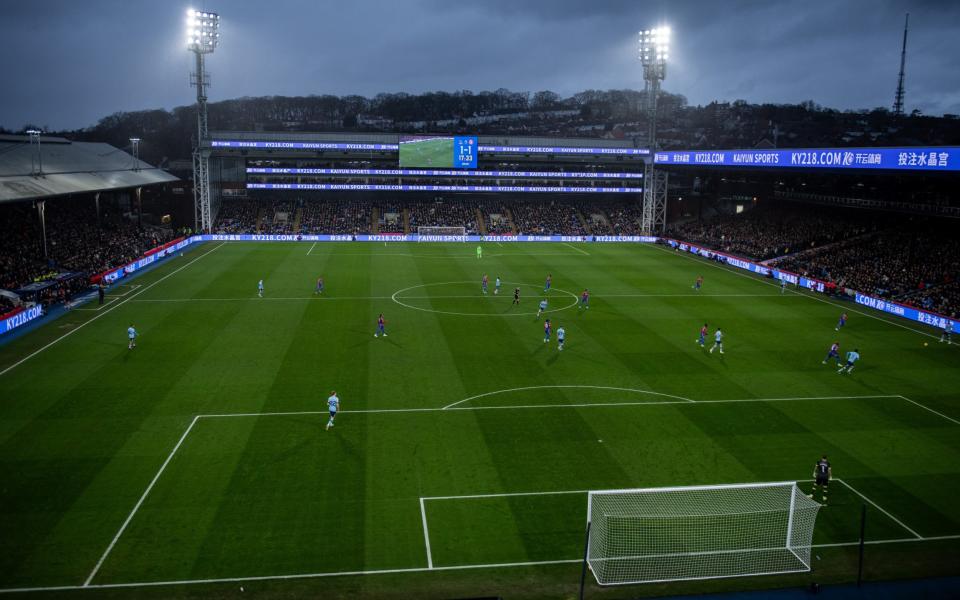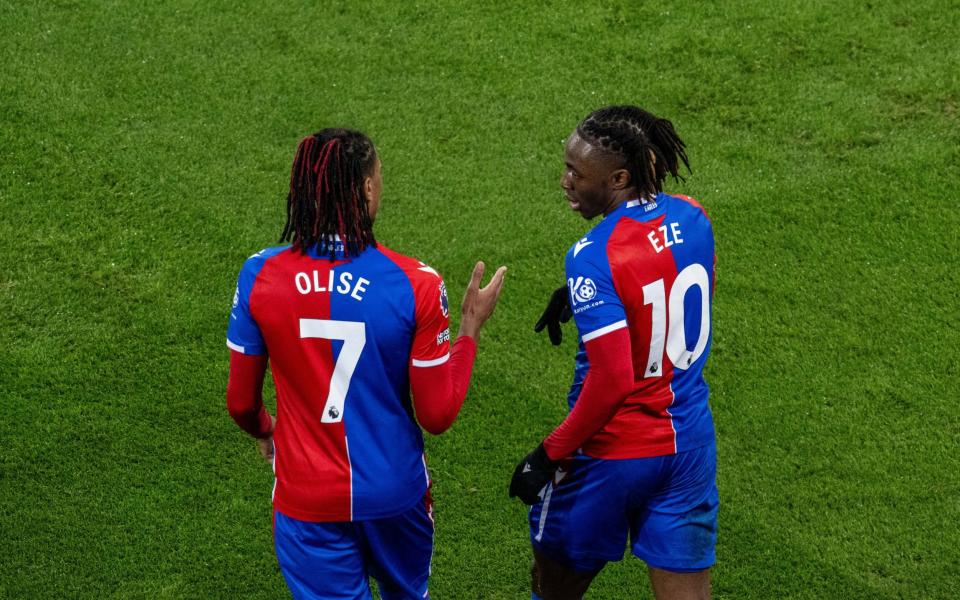The latest round of raising capital from Crystal Palace shareholders for the club’s new Selhurst Park main stand entered its final stages this week, which will be the first major work on the stadium since the 1990s – although this will not mean enough change for many.
There was more discontent at Goodison Park on Wednesday night – with the FA Cup defeat, Roy Hodgson’s substitutions and a general dismay at a section of the club’s support who have declared themselves unhappy with the status quo. What is that status quo? Strictly speaking, this is the most successful period in the history of one of Britain’s oldest clubs. Palace are in their 11th consecutive Premier League season – the longest uninterrupted spell in the English top flight in more than 100 years of competitive football.
Palace have also come close to a first major trophy – an FA Cup final in 2016 and a semi-final six years later – but football clubs are never easy. Fan mood rises and falls depending on many factors that cannot always be offset by predictions for a better future.
Hodgson has kept Palace in the Premier League for five seasons, including when he returned last March after Patrick Vieira. If this season is to be the end of a 48-year managerial career, then Hodgson’s performance has been remarkable. He has outlived all comparable European peers. For example, he may meet Arsène Wenger on Saturday when Palace visits the Emirates. The Frenchman is almost two years younger than Hodgson. Hodgson may not have as many trophies as Wenger or others like him, but they have not been in demand for so long.
Hodgson has seen enough in football to know that no matter how good the long-term strategy is, there are many who simply don’t want to hear about it when results deteriorate. In a game that runs on emotions, the mood can quickly change. The Palace plan to turn Premier League and investor money into infrastructure – stadium, training ground, academy – is the only viable long-term strategy. Still, the clamor for a transformative signing – someone, anyone – can be overwhelming.
Momentum needs to be generated in the last few days of this period. Chairman Steve Parish and director of football Dougie Freedman are active in the market, and Kalvin Phillips could add another addition to a midfield department hit hard by injuries. Like many others, Palace are also looking at a striker and a right back. But this is a club that has slowly built its fortunes in the Premier League since an unexpected promotion in 2013. That plan won’t change.
Palace are in the bottom eight of the division when it comes to revenue generation. Over 13 years, since the club came out of the administration of the consortium led by Parish, around £80 million has been invested. Nothing compared to the big investments from owners at Manchester City, Newcastle United, Chelsea, Everton – and even Tottenham recently. But these types of fossil fuel billionaires, private equity and national investors are not lining up to buy Palace.
The club now generates around £130m from central television rights payouts and around £40m from commercial and matchday revenues, depending on league finish. Just a drop compared to the league’s big hitters. The £160 million investment in the new Main Stand, the first serious modernization of Selhurst Park since the rebuilding of the Holmesdale Stand in the 1990s, could ultimately generate a further £20 million in annual revenue.


All this takes time. Meanwhile, competition is fierce. Aston Villa has wealthy owners who are expanding Villa Park. West Ham had a stadium built and subsidized for them by the government. Tony Bloom has invested more than £400 million in Brighton. All of these clubs were once Palace’s mid-table rivals and have all played in the Championship for the past fifteen years. Yet in 2024 the standard among that cohort will continue to rise.
Hodgson has led Palace through a crucial era in rebuilding the training ground and academy at a cost of £50 million, including land purchases. The club recognizes that it needs to do more to develop and sell academy players and the investment is partly with that in mind. The final phase – a rehabilitation center for serious injuries – will start in May and with it the reconstruction of a training ground that was never really a training ground in the past. For a long time they were only temporary huts and associated pitches.
For Hodgson, the challenge this season will be dealing with some of the restrictions on spending that investment in other parts of the club may bring. Injuries to Michael Olise and Eberechi Eze have hit his team hard this season. Cheick Doucoure tore an Achilles tendon in November and will not play again until 2024/2025. These three, like Marc Guehi, represent the club’s best assets and Hodgson’s successor may have to deal with the sale of one or more in the summer.
But that’s the reality of life at a club where the two previous properties faced administration, including the separation of stadium and club. The current regime is determined to do things differently. But with just five league wins all season, frustration can run rampant, as happened at Goodison on Wednesday. Hodgson tried to solve an ankle tendon problem that was bothering Eze and replaced him with a lunch kick-off at Arsenal on Saturday in mind. The traveling fans reacted poorly.
There are many reasons why Palace’s squad is thin. The wage bill is around £100m when all extras and bonuses are added up, meaning that under the new financial fair play rules likely to come in – known as squad costs – Palace will have to increase revenues to meet demands . The club takes its Profit and Sustainability Rules (PSR) as seriously as you would expect, and in the current climate of enforcement that is no small consideration.
The club has occasionally tried to take a different path. Signing better-paid established players like Yohan Cabaye and Christian Benteke, without resale value, had a distorting effect on the wage bill and is unlikely to happen again. The success of the signings of Olise, Eze, Guehi, Doucoure and Joachim Andersen has set the bar high. The recruiting department has recalibrated to accept that not every player can be expected to check all the boxes, including good resale value.


Hodgson has been clear in recent months about what is realistic for supporters to expect. He would later apologize for stating that fans were “spoiled.” Yet the point made is true. Are fans willing to tolerate the process of building a club in the modern era? Especially if that construction comes from a very low base, amid extraordinary competition and under the auspices of PSR. The recent PSR charges for Everton and Nottingham Forest offer a new dimension.
Palace’s situation could be better and it is not difficult to argue against the survival prospects of the lower mid-tables or the relative success of their peers. But it could also be much worse, and with this approach there is a clear strategy: increase Palace’s financial capabilities to take them beyond the reach of the division’s lowest earners and look beyond the annual struggle for survival in the Premier League.
“They have seen the trials and tribulations, and I am sure one day they dream that there will be no more trials and tribulations,” Hodgson said of the fans on Friday. “But they are used to helping the team through these periods.”
There is no billionaire waiting to buy Palace and spend up to the PSR limits and beyond on the stadium. We know this because, if that had been the case, the current property would have been sold. About 55 percent of the club is owned by Parish, American investors Josh Harris and David Blitzer, and various small shareholders. Eagle Football, led by American investor John Textor, has a 45 percent share. All shareholders will contribute to the new stand, with Parish personally guaranteeing around £5 million. Harris, an American sports franchise owner, is a billionaire, but not the kind willing to throw a fortune at Palace.
Meanwhile, it is Parish and Hodgson who are on the front line receiving the criticism. Being prepared to be unpopular, at least for a period of time, is a requirement that not everyone in football can live with. That said, neither man built their careers on constantly worrying about what people think.
The alternative, of course, is promising what you don’t have and spending what you can’t afford, even if there are consequences. Palace have sailed close to the wind in the Premier League and have turned survival into something of an art form in eleven years. The long-term prize – building infrastructure to increase revenue and ultimately increase roster depth – is the only sensible route to sustainability. It’s a good destination, although the drive there can be wild.